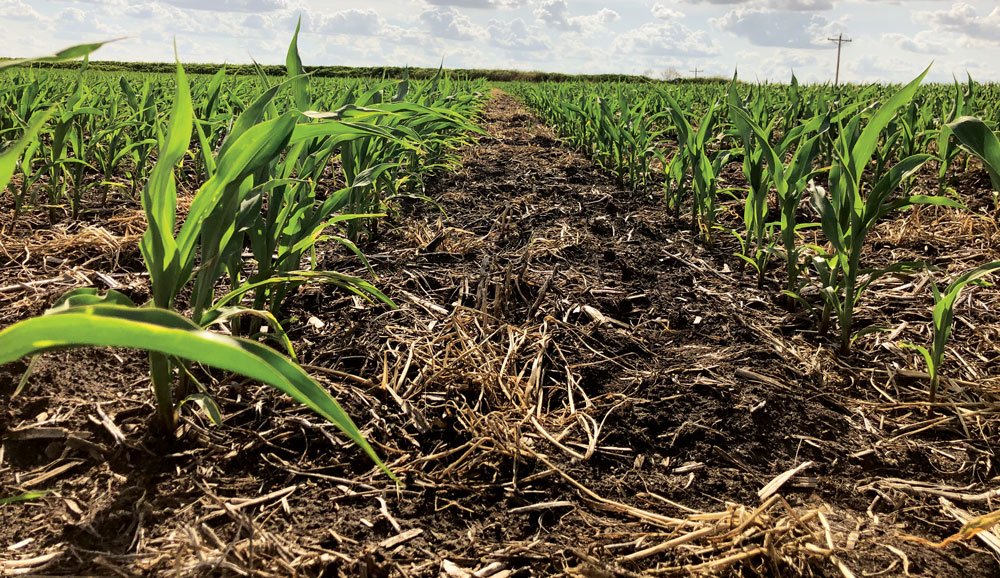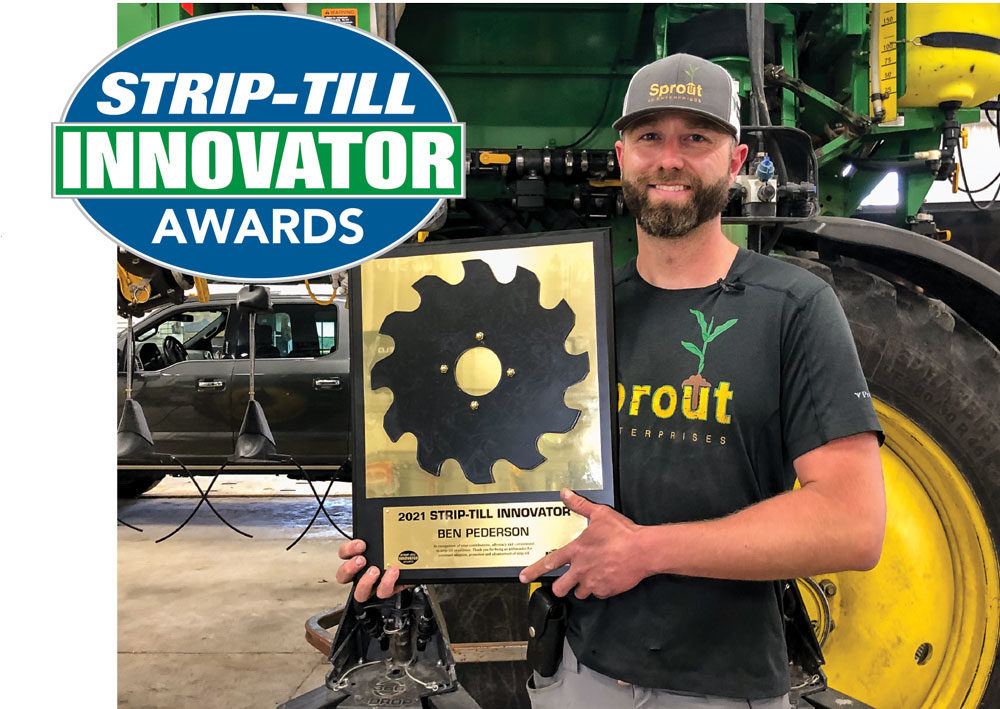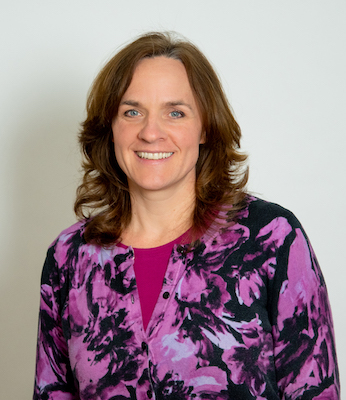Pictured Above: IMPLEMENTING INNOVATION. Ben Pederson of Lake Mills, Iowa, is boosting efficiency and improving the soil through strip-till, precision nutrient placement, prescription planting, cover crops and controlled traffic on his sustainable family farm.
Fostering an ethic of land stewardship while operating a profitable, efficient farming operation is a compelling mission, and one Ben Pederson has been following for the past decade. A third-generation farmer in Lake Mills, Iowa, Pederson and his dad, Gary, grow 4,000 acres of corn and soybeans about 6 miles south of the Minnesota border.
Pederson began strip-tilling in 2011, after his frustration with soil erosion and lost nutrients led him on a search for practices that would keep the soil in place, retain nutrients and reverse the degradation that he could see was inevitable under conventional practices.
“Conservation wasn’t my biggest emphasis for getting into strip-till. It was more that I wanted to band my fertilizer and make a better seedbed, which I did,” he says. “But once I tried it, I loved how we infiltrated water across the hilltops and across every acre more efficiently. And I loved how we kept our soil from blowing and washing away and we’re able to control our field traffic.”
Now after a decade of refining techniques to reduce waste and streamline his operations, Pederson has been named the 2021 Strip-Till Innovator Award winner.
In addition to operating the farm, Pederson also runs Sprout Ag, a sales and service company that does planter retro-fits, builds custom SowMaster planters, does custom nitrogen and fungicide applications and yield monitoring.
Aligning Machinery
Prior to strip-till, the Pedersons were farming conventionally, using a disc ripper after corn stalks followed by a field cultivator and then a soil finisher in the spring, practices that left the land vulnerable to erosion.

FROST SURVIVORS. A frost event in late May 2021 damaged some of the crops on Ben Pederson’s farm, which sits just 6 miles south of the Minnesota border. For the most part, he says the corn was small enough at the time that it made a full recovery. Some of his soybean acres weren’t as lucky and had to be replanted.
“Needless to say, we’d always have those 3-4 inch May rains and they’d come fast,” he says. “I didn’t like how the gullies washed and the water that looked like chocolate milk would be headed down the intakes. So I was looking for something better.”
Pederson’s dad was concerned about changing tillage practices at first. “He was worried about the soil not warming up enough in the spring and residue problems, but now all of his acres and the acres I manage are all strip-till and managed with one set of machinery,” he says.
“The nice thing is we were able to keep most of our tractors and planters the same for the most part. The planters have a little bit different equipment on them, but mostly it was what we do in front of the planter and behind the combine that changed,” Pederson says.
The equipment changeover was a major step in improving overall efficiency and soil health, as they were able to standardize the widths of their implements, getting everything on 60- or 120-foot widths.
“I like the fact that we’re fertilizing and tilling at 60 foot wide vs. before when we would hire somebody to spread fertilizer for us behind the combine and then we’d take out our disc ripper, which was less than 20 feet wide, and have to cover all those acres,” he says.
Switching to strip-till has allowed Pederson to cut fuel use associated with tillage and fertilization in half. In addition, dry fertilizer costs have been reduced by perhaps 25%, he says, though the exact percentage is hard to pinpoint because he uses crop removal recommendations from different sources, taking a blended approach to developing nutrient prescriptions.
For a strip-till rig, Pederson uses a 60-foot, 24-row Environmental Tillage Solutions (ETS) Soil Warrior on 30-inch rows. The Soil Warrior is set up with a coulter system tilling 4-6 inches deep and blowing fertilizer in behind it. Pederson shifts over 15 inches every year to give each set of wheel tracks a rest.
“I believe in doing coulter tillage vs. a mole knife, which can allow strips to blow out, especially on some of our more rolling ground,” he says. “By going shallower, I’m trying to reduce that even more. We’re running deep units around our wheel tracks because we know where those compacted strips are, so I’m trying to use a more aggressive unit on those rows to try to tear that up and reduce the impact on crop growth a little.”
Communicating the Value of Regenerative Practices
Pederson stresses the importance of farmers finding a way to get out of the ‘commodity rut,’ as he calls it, and adding value to what they do through differentiation.
For him, it’s important to tell the story of regenerative agriculture in a way that helps the public understand the strides he’s making by changing practices. He rattles off some benefits of regenerative ag, saying “farming the land the way we do vs. the conventional way of doing it is the equivalent of taking 94 cars off the road for every 160-acre field. It also saves 12 dump trucks of soil.”
Aware of the mainstream narrative that organic farming is better for the environment, Pederson explains why he chose not to go organic. “There’s a lot of tillage involved and I’ve seen such great benefits from reducing our tillage that I’m just not convinced that for us it’s the way to go,” he says.
In fact he makes a point that non-organic farmers can produce vitally important products while improving the land and leaving it in better shape for future generations. “There’s a great science-based story to tell that there’s nothing about using GMOs and properly applied herbicides that’s detrimental or harmful to the food system. We’re producing grains that are pesticide-free and that are becoming more nutrient-dense as our soils improve,” he says.
“And one thing that I always try to drive home to non-farm family or friends is that we’re mindful of this stuff. We’re not just doing whatever big ag corporations tell us to do. We live here, we drink out of the wells. So it’s top of mind when we’re applying pesticides. We’re doing it correctly, according to the label, and in way that’s safe for the environment, the crops and humans.”
The Pederson’s planter, a 60-foot, 24-row SowMaster on 30-inch spacings, is built on a Harvest International chassis toolbar and features several Precision Planting attachments, including vSet meters with electronic vSet drives, DeltaForce to keep the row unit at the optimal depth and limit sidewall compaction, SpeedTube seed delivery, the FurrowForce closing system, SmartFirmers, FurrowJet, vApply HDs, and the mSet dual hybrid system.
One of the few dual hybrid planters available, the SowMaster allows Pederson to variable-rate seed two different hybrids at the same time to place defensive hybrids in more marginal soils and offensive hybrids on soils that are higher in organic matter and better drained. Seeding rates range from about 30,000 in the poorer soils up to 38,000-39,000 in areas with higher organic matter.
Pederson’s 120-foot John Deere 4038R sprayer drives along every other planter pass. Pederson touts the sprayer’s ExactApply technology, as it automatically maintains boom pressure at any speed, which helps reduce drift. It also has turn compensation so he can avoid over-spraying on the inside of the boom and under-spraying on the outside while turning.
Triple Relay Fertilization
Pederson builds berms both in the fall and spring, using a “triple-relay” approach to fertilization, applying nutrients with the strip-till rig, at planting and again at sidedress.
“Sometimes if the fall weather isn’t ideal because it’s too wet or it’s freezing up, we just get our dry fertilizer on and make a little itty-bitty strip. And then in the spring, we come back and refine the strip, improving the seedbed by cleaning the residue and exposing a little more black soil to get it warmed and dried.”
Pederson applies both dry and liquid fertilizer with the strip-till rig, including ESN urea to prevent leaching during adverse weather conditions, and liquid phosphorus (P), nitrogen (N) and sulfur in a 2-by-2-inch configuration.
In the fall, Pederson applies 100-300 pounds of potassium sulfate along with zinc, boron and calcium.
“I like calcium because it’s a large molecule that can help make soil less compactable and because it plays a really important role in getting other nutrients into the plants,” Pederson says.
In areas where pH doesn’t need adjustment, Pederson likes to use pelletized gypsum as a calcium source because it also contains sulfur. He uses pelletized lime if he needs to adjust pH.
In the spring, a base rate of P (10 gallons of 10-34-0) is applied as a liquid with the Soil Warrior, and then the same liquid fertilizer is applied with the planter using Precision Planting’s FurrowJet to go ¾ inch into the sidewall.
Pederson uses a high-clearance sprayer outfitted with Y-Drops later in the season to sidedress additional N. Total applied N is usually 170-185 pounds, but Pederson says he uses a slightly higher rate for corn-on-corn to ‘pay the carbon penalty.’
“I believe in fertilizing for both crops. I like to have fertility where my soybeans are going to grow and I like to have fertility where my corn is going to grow. By hitting it in the fall, we can do that,” he says. “And then when we’re planting soybeans, we just plant into stale strips without hitting it again in the spring, like we do with the corn to add the nitrogen.”
Acknowledging that this system requires a lot of management, Pederson says banding nutrients is important to feed the plants what they need, when and where they need it.
“There are interactions in our soil, which I don’t claim to understand — interactions of chemical, biological and physical properties — that can cause nutrient tie up, where negatively charged nutrients, like phosphorus, can get tightly held by soil to the point where it’s not available to the crop,” he says.

GOING WIDE. The 120-foot John Deere 4038R sprayer Ben Pederson uses on his Lake Mills, Iowa, farm allows him to efficiently cover the 4,000 acres of the controlled-traffic, corn-soybean operation he runs with his father, Gary, and three employees.
“If I can put nutrients in easy intercept distance to a plant’s roots — for a corn or soybean plant, I think it’s about a 4-inch cube underneath the plant where it draws most of its nutrients — then I don’t really care what the nutrient level is outside that strip.
“If I can feed that crop right where the roots are, then I’m only fertilizing at most a third of the soil and I can give that crop a higher density of fertilizer in that feeding zone than I could by broadcasting.”
Living Roots
Another important part of the soil health equation for Pederson is using cover crops. He seeds covers in the fall using a third bin on the Soil Warrior while building berms, which means he can get them in the ground without a separate pass. The cover crop seed is broadcast across the entire toolbar, so it goes both in the strips as well as between them, where rain and biology can help it germinate.
“We do get a good catch in the strip, which I’m fine with,” he says. “It helps hold the soil together because what I’ve found is the longer I’m in strip-till, the more the soil outside of our traffic patterns gets almost unmanageably loose, which is an unintended consequence of reducing compaction in those areas. So we’re having to find ways to manage that and having some living or dead roots, holding that strip together for the planter and the spring nitrogen applicator can be advantageous.”
Pederson began dabbling in covers in 2013 due to a prevent plant situation. While he has experimented with a variety of cover crops, including kale, vetch and clovers, he mostly uses cereal rye, which helps hold soil in place during spring rains and snow melt.
For past 3 years, Pederson has been trying to seed cereal rye on all his acres at a rate of 50 pounds per acre. Citing improved water infiltration, reduced soil erosion and compaction and noticeable suppression of the usual early flush of broadleaf weeds, he says “I’ve seen really favorable results, even before corn.
“I haven’t found it to have an allelopathic effect. I believe that’s because we’re banding fertilizer right where it needs to be and not having the cereal rye steal it from the corn. And we’re trying to terminate it in a timely fashion as well,” he says.
“Other than that, it seems like it jump-starts the soil biology and gets it ready to grow our cash crop. It’s nothing I measured, nothing I could put my finger on, but we’ve raised pretty nice crops behind what would have looked, to my father’s generation, like an unacceptable, weedy mess.”
“If I can put nutrients in easy intercept distance to a plant’s roots, I don’t really care what the nutrient level is outside of that strip…” – Ben Pederson
Growing cover crops northern Iowa isn’t easy, he says. “We’re so far north, that a lot of times, we get it seeded in the first week of October, and then our average temperature could be in the 40s a week later, so we don’t get a lot of growth or even germination sometimes.
“So we’re trying to chase the combine in soybeans with the Soil Warrior to seed the cover crop. Some years we get a nice flush in the fall, but most years I’m depending on good growth in the spring and most years we get it. It’s kind of the game we’ve got to play up here.”
Pederson has tried interseeding and aerial seeding, but hasn’t quite hit on a method that really makes him happy. “I haven’t found the perfect way of doing it. Switching to strip till was easier than coming up with a cover crop routine that works consistently,” he says.
“But I think it’s worth doing, because we’re trying to mimic how the soil was designed and how it came into existence, which was as a prairie with diverse species, and not just growing one crop at a time. So that’s the root of why I’m doing it but in terms of the how and the what and the why, I’m still searching for the best way that’s logical and makes sense in dollars and cents.”
While seeking a financial payoff is elusive because “it’s not a linear equation,” as Pederson says, he’s considering the sum of all the parts when evaluating the benefits. “If we can increase microbial activity, that’s a positive thing, so I’m gaining that. I’m gaining by not losing soil. Piece by piece, I’m reducing compaction — the more I can let those cover crop roots explore, the less I have to destroy with iron. Plus, if there’s any nitrogen left over from the previous year’s crop, it’s sopping that up and holding it in a biological form and becoming green manure for the next crop. So it’s all these little pieces that are helping us out.”
The 2021 Strip-Till Innovator program is supported by Montag Mfg.

While one gets the sense Pederson has analyzed the unknowns out of every operation, he does take some calculated risks when it’s beneficial to do so, such as when he seeds a cover crop before non-GMO corn.
“Some people would say it’s barely better than suicide because you need glyphosate to be able to kill that cover crop,” he says. “But with the help of this sprayer, where we can cover a lot of acres, we’re able to kill that cover crop in time before the crop comes up and we’re off to the races. Because obviously without Roundup-Ready crops, you kill your corn as well.”
Raising non-GMO corn at this point is mainly a cost-saving mechanism, as Pederson says he currently doesn’t have a market that offers an attractive premium.
Continuous Improvement
Despite pursuing efficiency and innovation, Pederson avoids setting rigid goals. “I’m more interested in continuous improvement,” he says. “A lot of times, that means continuing to learn and talking with peers or other people in the industry that have new ideas. If I’ve got my eyes and ears open, I can be ready for whatever comes my way.
“I’m just constantly looking for a new idea, a new product or a new way of doing things in my attempt to raise more with fewer inputs, less time, and less need for specialized manpower as things get more complex.”
As for being the recipient of the 2021 Strip-Till Innovator Award, “it’s humbling,” he says. “It’s great to be recognized in an industry that I’m really passionate about, that I’ve been working in as long as I’ve been able to work. Yet I certainly can’t take credit for all the ideas that I’m employing to make our farm as good as it could be. With virtually everything we’re doing, somebody more innovative and inventive than me tried it first.”







